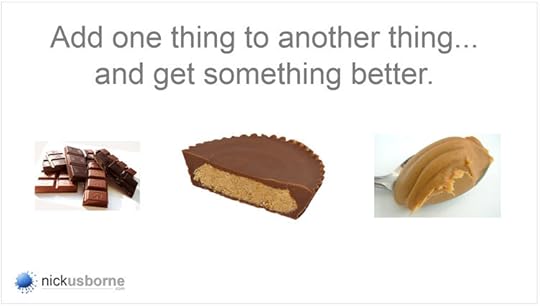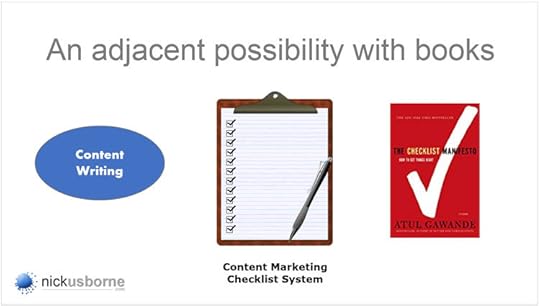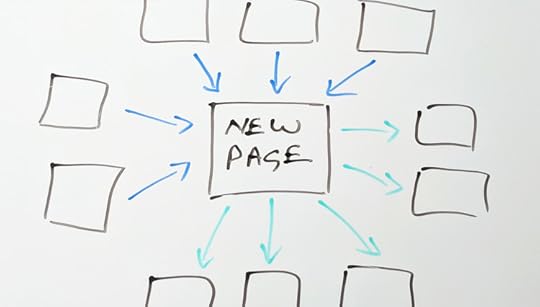Nick Usborne's Blog, page 10
October 30, 2017
Adjacent possibilities for freelancers who want more.

This post is based on a one-hour presentation I have given a couple of times this year.
I won’t try to include the full hour of information, or the 29 slides.
But… I hope to communicate the value and power of adjacent possibilities for freelancers.
To start with… what does that even mean?
The phrase is not my own. As far as I can tell, it was first used by Stuart Kauffman, a theoretic biologist. He used it to explain aspects of the evolutionary process.
Steven Johnson, author of the excellent book, Where Good Ideas Come From, introduced the phrase into the non-technical world.
And now I see there’s even an ad agency out there using the phrase as its business name.
Put simply, an adjacent possibility is this…
Think of two adjacent ideas, mix them together and get something new that has more value than either of the separate ingredients.
So… take a bowl of chocolate and a bowl of peanut butter. Not the same thing, but kind of related… both foods, but not essential foods.
They’re not the same, but not totally different. They’re adjacent.
Now put them together… and you get Reese’s Peanut Butter Cups.
Another example…
A laptop of is really useful, but kind of heavy to carry around the house or to your favorite coffee shop.
A smart phone is super-light and portable… but has that tiny screen.
Again, these two items are different, but similar. They’re adjacent.
Put them together and you get… a tablet computer.
Why this matters…
Having good ideas is hard. And most of us think that to have an idea with any real value we have to start with a blank sheet of paper.
If we stare at the sheet of paper long enough, and have tons of creative thoughts, we might come up with a really exciting new ides.
Trouble is, it’s going to be a highly risky idea… simply because it’s all new.
But if you start with a couple of existing, adjacent ideas on that piece of paper, and create something new, the level of risk goes way down.
Hey… chocolate and peanut butter? Give it a try. It’s a low-risk and high-reward scenario.
What does this have to do with freelancers?
Good question.
The trouble with raising your hand and saying you’re a freelance writer, a freelance copywriter, a freelance designer, a freelance coder or a freelance anything else… is that you are immediately perceived as a commodity.
You’re a freelance content writer? OK, but with a few clicks I know where I can access a zillion other freelance content writers.
Our challenge as freelancers is to differentiate ourselves in a very busy and noisy marketplace.
How to differentiate yourself by playing the “game” of adjacent possibilities…
Grab yourself three index cards. Lay them out in a row, left to right.
On the left hand card write Content Writer. (Or whatever your core skill is.)
Now, on the right hand card, write down the name of a good non-fiction book you have read. Actually, grab 10 index cards and write a title of a book on each one.
The left card says content writer, the card on the right has the name of a book you have read…
And for now, the card in the middle is blank.
To find something for that middle card we need to combine the left and right cards and see if you get an equivalent of a Reese’s Peanut Butter Cup.
Here’s an example from my presentation.

On the left I identify myself as a content writer.
On the right is a book I have read called The Checklist Manifesto. (Excellent book!)
By mixing the two outer cards together I have created something new. I have a Content Marketing Checklist System.
Or at least I have the beginnings of an idea. And I bet if I developed that idea I could come up with something my clients would love.
And once I became the Content Marketing Checklist System guy, I’ll never again have to worry about being mistaken for one of those “commodity” content writers.
I’d stand in a class all my own, and charge a lot more for my services.
1+ 1 = 5. Or something close.
You may have to try this with 5, 10 or 20 books before you come up with anything interesting. But why not?
Another example…
I’m going to keep Content Writer on the left card and then, on my set of right hand cards I’m going to write some other skills I have.
Not any skill. It needs to be reasonably adjacent.
For example, one of my skills is that I can milk a cow. Bet you didn’t know that! But it’s definitely not adjacent. Fun fact, but not helpful.
But I do have some reasonable design skills. After school I went to art college for a while. (Bet you didn’t know that either.)
So on one of my cards on the right I’m going to scribble “design”.
Hmmm… Mix those two cards together and I could come up with “web content design”.
Is that a thing? I think it totally could be. Social media in particular is becoming increasingly visual. All the time now we’re seeing words and images working together and being posted to various social media channels.
I could do that. I could become a web content designer.
And again, I’d be differentiating myself and increasing my perceived value.
Keep playing the game…
Play with these index cards.
The card on the left usually describes one of your primary skills.
With the card on the right you can take all kinds of routes to find something adjacent.
Could be a book.
Could be a secondary skill you have…like design, research, editing, teaching, videography, translation.
Could be a skill someone else has… mixing up your skills with the different but complimentary skills of someone else.
In my presentation I go through a lot of other examples of how this “game” can work.
And maybe I’ll write some follow-up posts to dig a little deeper.
In the meantime, get busy with those index cards.
Play around with them and see what you can come up with.
Remember, the idea is to combine two adjacent ideas into a whole new possibility and opportunity.
That opportunity will help differentiate you as a freelancers and give you a 1+1=5 jump in value.

If you found this post helpful, sign up for my e-newsletter and get a free copy of my 35-page guide…
Writing For The Web #1 — 7 Challenges every Writer and Copywriter faces when writing for the Web.
Sign up and I’ll send you the link for the download, and then you’ll receive my most recent post as part of my e-newsletter every Tuesday morning.
Sign Up for my Excess Voice Newsletter…
Name:
Email:
0 subscribers
We respect your privacy
Email Marketing by GetResponse
(Your email address will be used only for the purpose of sending you this newsletter, and you’ll be free to unsubscribe at any time.)
The post Adjacent possibilities for freelancers who want more. appeared first on Writing for the web - online copywriting and content writing..
October 13, 2017
Why NOW is the time for Conversational Copywriting.
Back in the days before the web, media channels worked just one way.
You couldn’t talk back at your TV screen.
You couldn’t talk back at a billboard.
As a result, as copywriters, we had a style and approach that worked for one-way media.
That’s certainly the training I received, back in the early 1980s.
We were in control of the message and the medium… and our style evolved from that place of control.
Our copywriting style certainly wasn’t conversational, because with one-way media there is no conversation.
And then along came the web.
The web is the world’s first mass-medium that is truly two-way.
For everything a company publishes, billions of individuals can respond… within the same medium, on the same platforms.
That’s a heck of a change and transformation.
The arrival and explosion of social media and smartphones simply amplified the two-way, conversational nature of communications online.
Now… companies that still communicate in that old-school, in-your-face style stand out as oddities… like a guy turning up to a weekend backyard BBQ wearing a business suit.
In a world of two-way media, conversation is the norm.
When a company responds to comments on its Facebook page it’s forced into conversation. That space is conversational by definition.
And every company would do well to take the lessons learned from those social media conversations and apply them across all its online platforms… its website included.
Traditional, broadcast, in-your-face sales and communication copy worked in the old, one-way world.
It doesn’t work in a two-way world.
Today’s online copywriters need to understand what’s different about writing online and develop their conversational copywriting skills.
Everything you write… whether it’s a sales page a homepage or an email… write it is a tone and style as if it were just one part of an ongoing conversation.
NOTE: I have an entire course devoted to the craft of Conversational Copywriting. (This link takes you to my Nick Usborne Training website.)

If you found this post helpful, sign up for my e-newsletter and get a free copy of my 35-page guide…
Writing For The Web #1 — 7 Challenges every Writer and Copywriter faces when writing for the Web.
Sign up and I’ll send you the link for the download, and then you’ll receive my most recent post as part of my e-newsletter every Tuesday morning.
Sign Up for my Excess Voice Newsletter…
Name:
Email:
0 subscribers
We respect your privacy
Email Marketing by GetResponse
(Your email address will be used only for the purpose of sending you this newsletter, and you’ll be free to unsubscribe at any time.)
The post Why NOW is the time for Conversational Copywriting. appeared first on Writing for the web - online copywriting and content writing..
October 9, 2017
English may be his second language, but his copy rocks.

It’s tempting to think the quality of the copy we write is determined in large part by our ability to write a decent sentence.
We’re wordsmiths, right? That’s the foundation of what we do. We have to be able to put together a sentence that works and makes good sense. We need to understand the basics of grammar.
So my heart sank when I was reading a homework assignment that came across my desk last week. (I’m running a training program right now, and the students submit assignments.)
From the very first sentence it was clear that English was not this writer’s first language.
So… I immediately assumed I was going to have trouble finding something positive to say about his work.
Ha! As is the case with almost all assumptions, I was dead wrong.
It turns out his submission was outstanding.
First, he followed the brief, missing nothing out.
Sounds like a no-brainer, but of the submissions I have received so far, not all have been precisely on brief.
Next, he picked up on something I placed in the brief… but didn’t emphasise. I mentioned it – without emphasis – just to see who would see it and run with it.
This guy did.
Actually, he not only saw it, but he developed the idea way beyond my own thinking.
That was a hallmark of his submission – taking everything I said several steps further. Way beyond what the brief asked for. Way beyond what was actually needed. But he did it anyway.
For example, in the briefing I mentioned the company would be inviting people to attend a webinar. That was it. I didn’t say a word about what the webinar would be about.
But this guy did. He imagined it, created it in his mind. Then he described it, building its value with a series of bullet points.
The result was that his copy had amazing pace and energy. He had imagined the company and its product to the point where it felt real and alive.
In fact, the copy was so compelling I stopped noticing the minor bumps in the road that, on a second reading, reminded me that English wasn’t his first language.
So what should he do about that? How can he get past those minor glitches in the English language?
Easy. He just hires an editor to take a quick look at his copy before he submits it to the client.
Make no mistake, this guy is an outstanding copywriter. And I think he’s fairly new to the game. But he has a lot of raw talent.
Beyond that… he puts in the work.
What does this all mean?
It means writing great copy isn’t about being able to achieve perfection in writing the English language.
It’s about paying close attention to the brief.
It’s about understanding what the client really needs, who his or her customers really are… and how to please them all, in spades.
It’s about digging deeper, working harder and using your imagination.
And finally, it means writing a page of copy that is carefully structured and paced, rings true, and leaves you feeling engaged, included and ready to take the next step.
Really. It was a great piece of work.

If you found this post helpful, sign up for my e-newsletter and get a free copy of my 35-page guide…
Writing For The Web #1 — 7 Challenges every Writer and Copywriter faces when writing for the Web.
Sign up and I’ll send you the link for the download, and then you’ll receive my most recent post as part of my e-newsletter every Tuesday morning.
Sign Up for my Excess Voice Newsletter…
Name:
Email:
0 subscribers
We respect your privacy
Email Marketing by GetResponse
(Your email address will be used only for the purpose of sending you this newsletter, and you’ll be free to unsubscribe at any time.)
The post English may be his second language, but his copy rocks. appeared first on Writing for the web - online copywriting and content writing..
October 2, 2017
No new web page exists in isolation.

Back in the old days, when I was young and writing print ads and direct mail. Before the web. Before everything was connected.
Back then, I could write each piece as a standalone element.
If I wrote a piece of direct mail, what came before and after someone read that package was simple and clear.
The “before” part involved a letter carrier delivering the letter to a prospect’s home.
The “after” part involved 1) The recipient dropping the letter and its contents in the garbage, 2) The recipient completing an order form and mailing it back or 3) The recipient calling a 1-800 number.
That was pretty much it. Easy. Simple.
Online things are a great deal more complicated.
If I write a new web page for a client, it never exists in isolation. There is no simple before and after.
Instead, there’s a crazy complicated before and after.
The before part could involve people coming to that new page via a link on the site’s homepage, or from other pages on the site. Or from an email or e-newsletter. Or from a tweet or YouTube video, or Instagram post and so on. Or from a paid ad. Or via a sponsored page of content.
Or, most likely of all, from a combination of several of the above.
As for the “after” part, that depends on the purpose of the page I just wrote.
Maybe the page’s purpose is to close a sale, or to get someone to sign up for something, or to presell them on a purchase as part of a longer campaign. Maybe it’s to get them to click through to another page, or one of three other pages. Or to another website altogether.
See what I mean?
When you write a new page for a website, you have to pay attention to what comes before and after.
To best navigate this complexity, here are three things to do…
1. Insist on a briefing from your client that includes a description of what comes before and after the page you are writing.
This sounds obvious, but more often than not I have had to make a point of asking a client to describe and show me the full context that surrounds the new page he or she is asking me to write.
How do people arrive at that page? Where are they coming from?
And most important of all…
What expectations have been set BEFORE people arrive at the new page I’m writing? What has been promised? What are visitors expecting to find and hear?
Super important.
And, of course, the purpose of your page will be defined by what comes after. Are you sending people to a shopping cart? To an information page or review page? To a sign-up page?
If you don’t know where people are meant to go next, you can’t truly understand the purpose of the page you’re creating.
2. Pay attention to the tone of voice and design of the pages that come before and after.
We are meant to be creating a smooth and friction-free experience for our readers. This means there shouldn’t be any weird or jarring shifts in either the tone or the look and feel of our page. It should fit in with the pages that come before and after it.
Again, if the client doesn’t give you access to the “before and after”, you won’t be able to write a page that creates a smooth and effective transition.
3. Make this part of your work process, and as a way to cross-sell your services.
I make a habit of asking for the before and after. Always.
This helps me do better work.
But it also gives me opportunities to expand the scope of my project.
Sometimes when I look at the before and after web pages or emails or e-newsletters, I might see something that is old, dated, poorly written or in some way out of sync with the rest of the flow. So I can turn to my client and suggest I rewrite those elements as part of an expanded project.
There have been years when I have probably come close to adding an extra 30% or more to my income simply by expanding the scope of projects in this way.
Wrapping it up…
It’s all too easy to just follow the brief and work on the pages we’re asked to write. Heads down and keep writing.
But online, where every page and screen is connected, you can’t do your best work that way.
You have to know what comes before and after.
Get into the habit of asking about what comes before and after, and you’ll do much better work.

If you found this post helpful, sign up for my e-newsletter and get a free copy of my 35-page guide…
Writing For The Web #1 — 7 Challenges every Writer and Copywriter faces when writing for the Web.
Sign up and I’ll send you the link for the download, and then you’ll receive my most recent post as part of my e-newsletter every Tuesday morning.
Sign Up for my Excess Voice Newsletter…
Name:
Email:
0 subscribers
We respect your privacy
Email Marketing by GetResponse
(Your email address will be used only for the purpose of sending you this newsletter, and you’ll be free to unsubscribe at any time.)
The post No new web page exists in isolation. appeared first on Writing for the web - online copywriting and content writing..
September 4, 2017
How to get into Conversational Copywriting, without faking it.

First, a definition of conversational copywriting.
To me, it means writing in the same way you would speak persuasively to a friend over the kitchen table.
Imagine you’re trying to persuade a friend to go hiking with you at the weekend. You’re in conversation, but you’re trying to be persuasive as well.
Because it’s within the context of a real dialog between two people, your language is natural and conversational. Emotional at times.
Your argument in favor of hiking isn’t carefully structured in the way a professional copywriter might put it together. No clever tips or tricks are used. No killer closing is deployed to “close the deal”.
Most important of all, unless you’re one of those really, really annoying friends, this will be a real conversation. You won’t just speak “at” your friend until you beat him into submission. You’ll ask questions. You’ll pause and allow him to say his piece too. There’ll be some back and forth.
You can do much the same in the world of online commerce
There are two sets of tools you can use when you choose to write more conversationally.
The first set is technological. It used to be that advertising and marketing went one way only. Companies broadcast their promotional messages through TV commercials, radio spots, print ads and so on.
Today we have the web, social media and mobile apps. This means communications can be two-way. For example, a business can choose to reply to comments on its Facebook page.
When a company does that – when it replies, whatever the channel – it is entering into conversation.
In this way technology is actually forcing companies to accept that the days of one-way, broadcast communications are behind us.
Ready or not, marketing today is about conversations with your prospects and customers.
The second set of tools is all about how you write.
Conversational copywriting should look and sound different from traditional, one-way, in-your-face copywriting.
It should feel less structured and be more natural. It should fit into a conversation over the kitchen table.
Here’s a quick before and after example.
Old-school copywriting to pitch a family resort:
The Oka Beach Family Resort’s all inclusive family vacations give you a top family vacation with your kids and time to reconnect as a couple, too.
Ouch… I don’t think real people ever talk in sentences that long. So let’s rewrite it in a more natural, over-the-table way:
A family vacation should be fun for everyone, right? That’s why we created a resort experience that’s all about the kids… AND all about mom and dad too.
Not a big deal. Just shortening the sentences, adding a question and simplifying the message. Suddenly the language feels a whole lot more natural.
Get the language right, and use conversational platforms like social media… and a business really can enter into genuine conversations with its prospects and customers.
Get it right, without faking it.
Watch some late-night TV and you’ll see a few commercials where the “talent” is talking to camera and pretending he’s your friend. Except, of course, he isn’t. He’s pretending to be having a conversation with you, but he isn’t.
Or read through some direct mail.
You’ll doubtless find some breathless writing all about how, “If you’re like me…” Add in some other cunning tips and tricks to make the reader feel she’s in the company of a friend and you get a some good “fake conversational copywriting”.
But none of it is real. Before the days of the web it was easier to pass fake conversational copy as being the real thing. But in today’s world of social media we know what real conversations with companies actually feel like.
Suddenly the fake, old-school, overly-copywritten approach to being “conversational” feels out of place and a little sad.
Bottom line… Conversational copywriting is about being real. It’s writing in a way that is less about “writing at” an audience – and is more authentic, as if you were talking with that friend across the table.
NOTE: I have an entire course devoted to the craft of Conversational Copywriting. Find out more about it here…

If you found this post helpful, sign up for my e-newsletter and get a free copy of my 35-page guide…
Writing For The Web #1 — 7 Challenges every Writer and Copywriter faces when writing for the Web.
Sign up and I’ll send you the link for the download, and then you’ll receive my most recent post as part of my e-newsletter every Tuesday morning.
Sign Up for my Excess Voice Newsletter…
Name:
Email:
0 subscribers
We respect your privacy
Email Marketing by GetResponse
(Your email address will be used only for the purpose of sending you this newsletter, and you’ll be free to unsubscribe at any time.)
The post How to get into Conversational Copywriting, without faking it. appeared first on Writing for the web - online copywriting and content writing..
August 28, 2017
It’s not always easy finding the sweet spot for your freelance business.

I get into conversations with a lot of freelancers, many of them just starting out.
And one thing I notice again and again is that freshly-minted freelancers often struggle to articulate exactly what their specialty should be.
B2C or B2B?
Which industry niche, if any? Financial, health, industrial, travel, other?
What kind of writing specialty, if any… sales copy, email, content marketing, social media writing?
It’s important to have answers to these questions. Without answers, you’ll often feel you have no real foundation. It becomes hard to articulate your position and your value to prospective clients.
In other words, if you aren’t completely clear about where you stand, and what you stand for as a freelancer, you going to have a lot more trouble marketing yourself and finding good work.
I try to address this issue in my course, Marketing Confidence. In fact, I come at it from a few different directions.
But even among those freelancers who have taken the course, some still struggle to paint a clear picture of where they stand and what they want to do.
So… here’s one more way to try finding an answer.
Grab a pad of lined paper. Or, if you must, open a new file on your computer.
Then, in big fat writing, like in the photo above, write:
The truth is, I…
Now you’re going to write a list of things. I’ll give you some examples in a moment. But the key here is to be true to the statement, “The truth is, I…”.
Forget everything you’ve learned about freelancing. Forget everything you have been taught in classes or courses, including my own. Forget the advice you picked up from the guru-of-the-month.
Instead, be totally and scarily honest with yourself.
For example, your list might look like this:
The truth is, I hate writing sales copy. Gives me the creeps.
The truth is, I wouldn’t like to work in the financial industry, even if it is profitable.
The truth is, I love the idea of writing editorial-style posts and articles for the gourmet food industry. That would be great, even if people tell me there’s less money in content writing. True? Not true? (Not.)
The truth is, I’m just not comfortable with the idea of putting a photo of myself on my homepage, even if people tell me it’s a good idea.
The truth is, I really want to work with local companies. I’d like to get out there and work with people face to face.
Get the idea?
Your list could be the exact opposite of the one above. Maybe you love writing sales copy and the financial industry, and so on.
Doesn’t matter what your list includes or says. This is for you, and nobody else’s opinion matters.
But most important of all are those first four words… The truth is, I…
This exercise will work only if you are absolutely honest with yourself.
What’s so special about this approach?
When you’re truthful about what you want, it’s enormously empowering.
“This is the real me. This is what I really want. This is the value I can bring to the table.”
It’s also a huge relief to shrug off the weight of what others tell you to do.
When your work is aligned with what you feel to be true, everything becomes a little clearer. A little easier.
Give this a try, as an exercise, and let me know if it helps.

If you found this post helpful, sign up for my e-newsletter and get a free copy of my 35-page guide…
Writing For The Web #1 — 7 Challenges every Writer and Copywriter faces when writing for the Web.
Sign up and I’ll send you the link for the download, and then you’ll receive my most recent post as part of my e-newsletter every Tuesday morning.
Sign Up for my Excess Voice Newsletter…
Name:
Email:
0 subscribers
We respect your privacy
Email Marketing by GetResponse
(Your email address will be used only for the purpose of sending you this newsletter, and you’ll be free to unsubscribe at any time.)
The post It’s not always easy finding the sweet spot for your freelance business. appeared first on Writing for the web - online copywriting and content writing..
August 14, 2017
Good news for freelancers: The gig economy is evolving in your favor.

The only upside to living a full hour away from my dentist is that I have plenty of time to listen to podcasts in the car.
Two pieces of good news from today’s trip.
First, no cavities.
Second, I listened to an episode of Jacob Morgan’s podcast in which he interviews Steve King.
Jacob Morgan is a best-selling author, speaker and futurist, focusing on the future of work.
Steve King is co-founder of Emergent Research, which tracks the future of small business and independent work.
During the podcast they have a wide-ranging discussion about the state of the gig economy and its future.
And yes, as freelance writers and copywriters we are dead center in the gig economy, along with Uber drivers, coaches, consultants and basically anyone else who, in the words of Dan Pink, works as a “free agent”.
About half way into the conversation Steve King talks about how things have shifted over the last few years when it comes to the reasons WHY companies hire freelancers or gig workers.
Reaching out to freelancers used to be driven by a desire to save money.
A company could save a lot of money by using freelancers from time to time instead of taking on a full time employee. Add up salaries, benefits, office space and more… and employees are expensive.
But it seem things are changing.
According to Steve King, when companies seek out freelancers they are no longer driven primarily by the promise of saving money.
These days they are more likely to be driven by the need to find skills and expertise they simply don’t have in-house.
So… no longer in search of savings. Instead… seeking out skills they don’t have within their company. Or maybe they have some employees with those skills, but not enough to meet demand.
This shift in priorities is great news for freelancers everywhere…
When companies were all about saving money, it put huge downward pressure on freelancers.
We felt we had to keep our prices down, both to appeal to cost-conscious clients and to compete with other freelancers.
That dynamic is now changing.
However…
MOST freelancers won’t listen to Jacob’s podcast, read his books… or come across this post.
MOST freelancer will continue to think that getting their next freelance gig is going to be all about price.
But you know better.
It’s now time to shift emphasis away from the price story and over to the value and specialty expertise story.
Do that and you’ll not only become more attractive to prospective clients, but you’ll also be in a position to charge higher fees.
All this goes to show that it makes sense to stay abreast of trends and new developments in the gig economy.
Stay tuned!

If you found this post helpful, sign up for my e-newsletter and get a free copy of my 35-page guide…
Writing For The Web #1 — 7 Challenges every Writer and Copywriter faces when writing for the Web.
Sign up and I’ll send you the link for the download, and then you’ll receive my most recent post as part of my e-newsletter every Tuesday morning.
Sign Up for my Excess Voice Newsletter…
Name:
Email:
0 subscribers
We respect your privacy
Email Marketing by GetResponse
(Your email address will be used only for the purpose of sending you this newsletter, and you’ll be free to unsubscribe at any time.)
The post Good news for freelancers: The gig economy is evolving in your favor. appeared first on Writing for the web - online copywriting and content writing..
July 24, 2017
If you don’t believe a new story can dramatically change your future as a freelancer…
People write to me with gentle challenges like, “Hey Nick, I love your enthusiasm for stories. But honestly, I don’t see how simply changing the story I tell can improve my future as a freelancer.”
OK… so you doubt the power of stories to influence your life?
You don’t think stories have the power to create change?
Let’s try a short experiment…
Imagine for a minute I’m able to reach into your mind and remove stories from your memory… one by one. I can just pluck them out. You’ll no longer remember those stories, or that you ever had them.
Ready? Let’s get started.
First, I’m going to go way back to your early childhood when your parents told you bedtime stories. I’m going to remove them all, all the way up to the age when you started reading stories on your own.
No more hare and tortoise. No more Jack and the beanstalk. No more cautionary tales or adventure stories. No more of those early heroes or villains. All gone.
And it’s not just the stories that are gone. You’re also going to lose everything you might have learned from hearing those stories. What makes a hero good? What makes a villain bad?
I’m going to take all the stories you heard at school as well. Stories from books you read for class. Stories told by teachers and friends.
Oh… and every history lesson too. All those stories you learned about the history of your country. They weren’t objective day-by-day records. They were stories. I’ll take them too.
And I’ll take the memory of every book you read as a teenager. All the movies you watched too. And the TV shows. And the lyrics from every song you ever loved. They were all stories.
Sports fan? I’ll take every story you ever told or heard about your sports heroes and the achievements of your team.
And just in case we forget, let’s remove all your family stories too. The stories you told around the dinner table during the holidays. You know, all those stories you shared that created bonds of memory and affection between you and everyone else in the family.
We’ll work our way through to the present… removing every story from your mind.
The result?
I think you’d be lost. You’d be empty. Maybe insane.
You’d have no idea who you were, where you belonged, what you believed.
By taking your stories I’d have taken away everything that enables you to make sense of the world, and your place in it.
OK… end of scary experiment.
Just make no mistake… stories have incredible power in our lives.
Every story you ever heard in the past has impacted your life as it is today.
In the same way, the stories you tell about your work today will profoundly impact the future success of your freelance business.
Which is why you’ll want to start telling new and better stories, immediately.
NOTE: If you’d like some help or guidance in unpacking your past and creating a better story for yourself, check out my one-on-one coaching program for freelancers… “The New Story of You”

If you found this post helpful, sign up for my e-newsletter and get a free copy of my 35-page guide…
Writing For The Web #1 — 7 Challenges every Writer and Copywriter faces when writing for the Web.
Sign up and I’ll send you the link for the download, and then you’ll receive my most recent post as part of my e-newsletter every Tuesday morning.
Sign Up for my Excess Voice Newsletter…
Name:
Email:
0 subscribers
We respect your privacy
Email Marketing by GetResponse
(Your email address will be used only for the purpose of sending you this newsletter, and you’ll be free to unsubscribe at any time.)
The post If you don’t believe a new story can dramatically change your future as a freelancer… appeared first on Writing for the web - online copywriting and content writing..
July 17, 2017
Don’t blindly accept the popular narratives other people follow.

We are all exposed to a wide range of narratives that are often accepted as truths.
But for the most part they are not truths. They are opinions. Stories.
And we’d do well to question them.
Let me share a couple of examples I have bumped up against recently.
One from my work life and one from my personal life.
Narrative #1: To get stuff done, you need to focus, distraction-free.
Sounds reasonable, right? I’ve told this story myself.
And then…
For the last month or so I have been struggling with the structure of a new course I’m creating. Struggling to the point where I was wondering if I’d ever figure it out.
I followed all the rules.
I carved out blocks of uninterrupted time. I immersed myself in the problem, distraction-free, with total focus. I even took up meditation again to help wrap my mind around the problem.
In other words, I did everything the experts say will help when you’re trying to resolve a complex problem.
No luck. At all.
So I decided to try something completely different.
I went cycling… during “work hours”!
Bad me!
I took a small pad of paper and a pen with me. You can see them in the photo above.
I’d start cycling, mindful of the problem I was trying to solve, but not concentrating on it.
Every few kilometers a thought would pop into my head. I’d stop, take out my notepad and take a few notes.
It took me three days, about 90 kilometers of cycling and a lot of notes. But I got there.
I couldn’t solve my problem by following the “approved” approach over the course of a full month.
But I cracked it in three days while cycling.
Old story debunked. New story shared.
Narrative #2: You can’t quit smoking and lose weight at the same time.
A little over a year ago I put myself on a diet and started to shed some pounds.
I knew I should also quit smoking.
But as my doctor told me, “Hey, you’re going to put on a few pounds when you quit smoking, so don’t try to quit smoking and lose weight at the same time.”
We’ve all heard that story before. Right?
But as I thought about it, I found myself forming a different opinion, and writing my own narrative.
It went something like this:
“I’ve been trying to lose weight AND quit smoking for literally decades, without success. But right now I’m losing weight with very little effort. So… if I’m in that kind of ”can-do” mindset when it comes to my health, surely now would be the BEST time to quit smoking as well.”
Sounded reasonable to me.
Fast forward to today and I’ve lost 35 lbs and haven’t had a cigarette in over a year.
Different story… different outcome.
Remember, almost everything people tell you is just a story, not a fact.
Can’t lose weight and give up smoking at the same time? Just a story.
Whatever the challenge in your freelance life, question those stories.
It can be hard to break free from a prevailing narrative.
For myself, the idea that I could actually get more work done by leaving my desk and going cycling was a huge break with my past.
Everything in my past screamed at me to put my nose to the grindstone and work hard until the task was completed. Only then, when the work was done, would I be allowed to go outside and “play” on my bicycle.
I come from a family and a school background where the traditional work ethic was drilled into me from a very early age.
First work. Then, if time allows, play.
As for losing weight and quitting smoking at the same time…
Part of the challenge there is that not only did I already know the story about not trying to do both at the same time, but my doctor repeated and reinforced that story.
When other people, particularly authority figures, reinforce an accepted narrative, it’s hard to break with it.
I was talking with someone this week who wants to become a freelancer, but her family and friends are all cautioning her to stick with her “real job”.
I’m sure they all mean well. They’re probably trying to protect her.
But the idea of traditional jobs being safer than freelance work is an OLD story.
It’s just not true anymore.
My point being… always question the stories and accepted narratives people hold up as reasons for you to do one thing and not another.
You always have the option to question, push back and write your own story.
NOTE: If you’d like some help or guidance in unpacking your past and creating a better story for yourself, check out my one-on-one coaching program for freelancers… “The New Story of You”

If you found this post helpful, sign up for my e-newsletter and get a free copy of my 35-page guide…
Writing For The Web #1 — 7 Challenges every Writer and Copywriter faces when writing for the Web.
Sign up and I’ll send you the link for the download, and then you’ll receive my most recent post as part of my e-newsletter every Tuesday morning.
Sign Up for my Excess Voice Newsletter…
Name:
Email:
0 subscribers
We respect your privacy
Email Marketing by GetResponse
(Your email address will be used only for the purpose of sending you this newsletter, and you’ll be free to unsubscribe at any time.)
The post Don’t blindly accept the popular narratives other people follow. appeared first on Writing for the web - online copywriting and content writing..
July 10, 2017
Freelancers: Telling the right story is like unleashing your own superpower.

Some of the most powerful stories we hear are the ones that support the narratives that define the countries we live in.
As I’m Canadian, I’ll use one of the dominant Canadian narratives to illustrate my point.
One of the stories that defines “being Canadian” is that we’re really, really nice.
We’re polite and friendly. We love animals and the environment. We welcome refugees with open arms. We make sure all our citizens have access to health care. We say please and thank you.
Really… we’re just super-nice people.
So goes the story.
And it more or less holds true until you start scratching the surface and digging down a little deeper.
Ask a few of the indigenous peoples of Canada how nice Canadians are and you’ll get a whole different story. It turns out we’re not so nice after all.
Or look at some of the aerial photos of the tar sands in Alberta. Oops, not quite as environmentally friendly as advertised.
Don’t get me wrong. I love Canada. I wouldn’t want to live anywhere else.
I could just as easily pick apart the prevailing narratives of the USA, the UK, France, Russia, Australia or any other country.
The point I’m trying to make here is that stories lie at the very foundation of how we make sense of the world.
Stories are used to define what it means to be a particular nationality.
Stories are also used to express the unique cultures of the regions or cities we live in. (Want to know what it means to be a New Yorker or a Londoner? Listen to their stories.)
And stories are definitely used to bind us together as families. Have you ever been to a family dinner, reunion, BBQ or other event that didn’t include the telling and sharing of family stories?
Almost everything we think of as being true, is actually just a story. And the more people repeat that story, the “truer” it becomes.
Think about it… stories are perhaps the most powerful force in our lives… and for the most part we barely even recognize the fact.
And how exactly is this relevant to your life and career as a freelancer?
It’s relevant because everything changes when you understand that stories are used to make sense of everything… including entire industries and individual companies.
Be a fly on the wall of any industry conference or tradeshow and you’ll hear the stories people tell to define the character, qualities and values of that industry.
Spend some time inside any individual company, large or small, and you’ll hear the stories that define the culture of that business.
So… as a freelancer…
You absolutely have to know and understand the stories that are prevalent within the industry niche you’re trying to serve.
If you don’t know their stories, and like their stories, you won’t be welcome. You won’t be “one of them”.
It’s like walking into a bar on the other side of the tracks. You walk in and you know right away you don’t belong. Everyone in the bar knows it too. You don’t belong because your life hasn’t been framed and moulded around the same stories.
Step 1 for any freelancer is to immerse yourself in your industry’s stories.
Dig deep and find out what those stories are. Be the fly on the wall.
If you walked into a bar – a different bar this time – where everyone inside worked in that industry, would you be familiar with the stories they are telling? (Most conversations in bars are simply the sharing of stories. Right? “You’ll never guess what happened at work today…”)
Get to know those stories. Look hard enough and you’ll find them. Industries and companies have defining stories in the same way that stories define what it means to be Canadian, American, French etc.
And make sure you feel comfortable with those stories, that you feel you would be happy to share them.
You have to feel enthusiastic about the industry you’re serving as a freelancer. You have to love their stories. If you don’t, they’ll know it.
Step 2 for any freelancer is to create your own story in a way that it overlaps and connects with the stories of your prospects.
Back to the bar…
When you walk into that bar for the first time, there needs to be a moment of mutual recognition.
The people who already belong there need to know that your story overlaps theirs. It doesn’t have to be exactly the same. But the stories do need to overlap.
For a real-life example, I have a coaching client who has a wonderful story of growing up as a total nerd in a completely nerdy family. The way she tells it makes me think of a Norman Rockwell painting. There’s something iconic about the picture she paints when she tells that story.
So guess which industry her prospective clients work in. Yep… the IT industry.
As soon as she tells her story, her audience knows she belongs. She’s one of them.
That one story of hers – which involves sitting around the kitchen table with her family, leafing through nerdy magazines – will make her irresistible to her clients and prospective clients.
Remember, we’re hard-wired to make sense of everything in life through the telling of stories… our nationality, where we live, our family, our workplace.
When my nerdy friend tell her story it’s like she’s unleashed a superpower.
She’s taken a super-fast shortcut into the hearts of her prospects. She’s gone from zero to total acceptance within the two minutes it takes to tell her story.
She has also differentiated herself from every other freelancer out there. Nobody else has her story. It’s true only for her.
If you want to be a freelance star, it’s not about the facts and the figures or the courses you’ve taken or the list of companies you have worked for.
All that stuff can help… but in supporting roles.
The true driver of your success will be a powerful story that goes directly to the heart of every prospect you approach.
So… what’s YOUR story?
NOTE: If you’d like some help or guidance in unpacking your past and creating a better story for yourself, check out my one-on-one coaching program for freelancers… “The New Story of You”

If you found this post helpful, sign up for my e-newsletter and get a free copy of my 35-page guide…
Writing For The Web #1 — 7 Challenges every Writer and Copywriter faces when writing for the Web.
Sign up and I’ll send you the link for the download, and then you’ll receive my most recent post as part of my e-newsletter every Tuesday morning.
Sign Up for my Excess Voice Newsletter…
Name:
Email:
0 subscribers
We respect your privacy
Email Marketing by GetResponse
(Your email address will be used only for the purpose of sending you this newsletter, and you’ll be free to unsubscribe at any time.)
The post Freelancers: Telling the right story is like unleashing your own superpower. appeared first on Writing for the web - online copywriting and content writing..
Nick Usborne's Blog
- Nick Usborne's profile
- 6 followers





